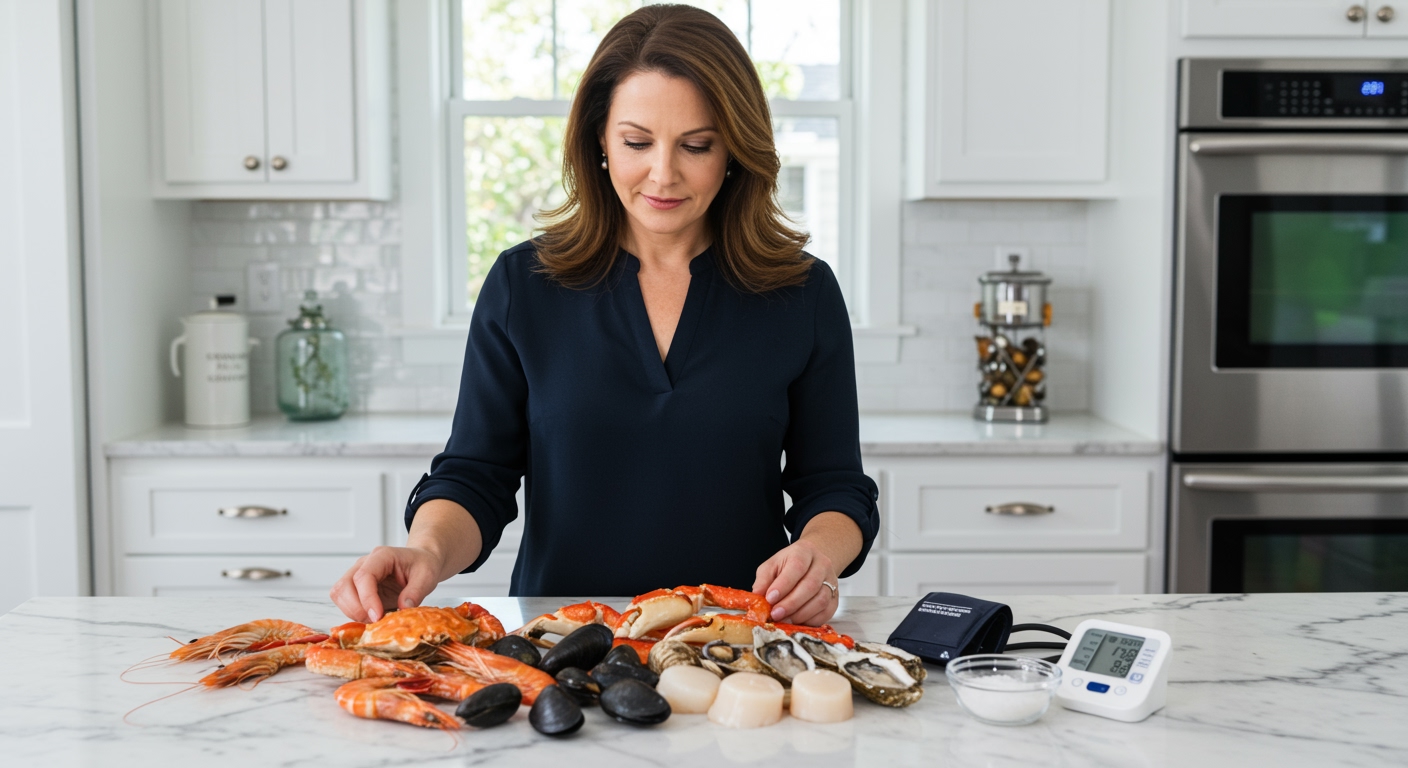✪ Key Takeaway: Shellfish can be good for high blood pressure when eaten fresh and prepared without added salt or heavy sauces.
Introduction
Your doctor just told you to watch your blood pressure and now you are staring at that plate of shrimp wondering if it will send your numbers through the roof.
You might be asking this question because shellfish has a reputation for being high in cholesterol and sodium, making you worry about your cardiovascular health.
Hi, I am Abdur, your nutrition coach and today I am going to explain exactly how shellfish affects your blood pressure and whether you can safely enjoy these ocean treasures.
Does Shellfish Actually Raise Blood Pressure?
The answer might surprise you because fresh shellfish naturally contains relatively low amounts of sodium compared to processed foods.
A 3-ounce serving of cooked shrimp contains about 190 milligrams of sodium, which is actually less sodium than a slice of bread or a serving of cottage cheese.
The real problem happens when shellfish gets prepared with heavy sauces, butter, or salt-heavy seasonings that can triple the sodium content.
Most restaurant preparations load shellfish with garlic butter, cocktail sauce, or breading that contains massive amounts of hidden sodium.
Your blood pressure responds to the total sodium load in your meal, not just the natural sodium in the shellfish itself.
When you eat shellfish prepared simply with herbs and lemon, you get the nutritional benefits without the blood pressure spike.
✪ Pro Tip: Steam or grill shellfish with herbs instead of using butter or heavy sauces to keep sodium levels manageable.
What Makes Shellfish Heart-Healthy?
Shellfish contains omega-3 fatty acids that actually help lower blood pressure by reducing inflammation in your blood vessels.
These healthy fats work by making your blood vessel walls more flexible, allowing blood to flow more easily and reducing the pressure on your arterial walls.
Research shows that people who eat seafood rich in omega-3s twice per week have lower systolic and diastolic blood pressure readings.
Shellfish also provides high-quality lean protein that helps maintain healthy body weight, which directly impacts blood pressure control.
The potassium content in shellfish helps balance out sodium effects by encouraging your kidneys to excrete excess sodium through urine.
Magnesium in shellfish supports muscle relaxation in your blood vessel walls, contributing to better blood flow and pressure regulation.
✪ Fact: Mussels contain more potassium per serving than bananas, making them excellent for blood pressure management.
Which Types of Shellfish Are Best?
Mussels and oysters top the list for blood pressure benefits because they contain the highest levels of omega-3 fatty acids and potassium.
These bivalves also have naturally lower sodium content compared to crustaceans like shrimp and crab.
Scallops provide excellent lean protein with minimal sodium when prepared without added salt or butter-heavy preparations.
Shrimp can be heart-healthy when you choose fresh or frozen varieties without added preservatives or sodium solutions.
Avoid pre-cooked, canned, or processed shellfish products that often contain excessive sodium for preservation and flavor enhancement.
Crab meat offers good nutrition but check labels carefully because some varieties are processed with sodium solutions that significantly increase the salt content.
✪ Note: Always rinse canned or processed shellfish under cold water to remove excess sodium before cooking.
How Should You Prepare Shellfish?
The preparation method makes the difference between a heart-healthy meal and a blood pressure nightmare.
Steaming shellfish with herbs, garlic, and lemon juice gives you maximum flavor without adding sodium or unhealthy fats.
Grilling or broiling allows natural flavors to shine while avoiding the heavy sauces that restaurants typically use.
Skip the cocktail sauce, tartar sauce, and butter-based preparations that can contain 300-500 milligrams of sodium per tablespoon.
Instead, create flavorful marinades using olive oil, fresh herbs, citrus juice, and spices that enhance taste without raising blood pressure.
Raw preparations like oysters on the half shell give you pure nutrition without any added sodium from cooking methods.
✪ Pro Tip: Make your own low-sodium cocktail sauce using fresh tomatoes, horseradish, and lemon juice instead of store-bought versions.
The Bottom Line
Shellfish can absolutely be part of a blood pressure-friendly diet when you choose fresh varieties and prepare them without excessive sodium or heavy sauces.
The ocean provides medicine, but the kitchen determines whether it heals or harms – your preparation choices make all the difference for your cardiovascular health.
I would love to hear about your favorite heart-healthy shellfish recipes or any questions you have about incorporating seafood into your blood pressure management plan in the comments below.
References
At NutritionCrown, we use quality and credible sources to ensure our content is accurate and trustworthy. Below are the sources referenced in creating this article:
- PubMed: Seafood consumption and components for health
- American College of Cardiology: Seafood and Cardiovascular Health
- British Heart Foundation: Fish oils and blood pressure powers
- Fulton Fish Market: DASH Diet Seafood





